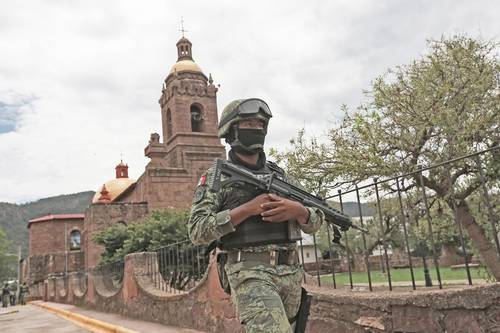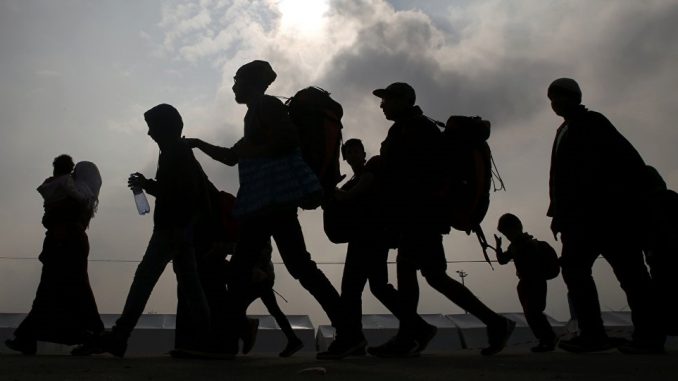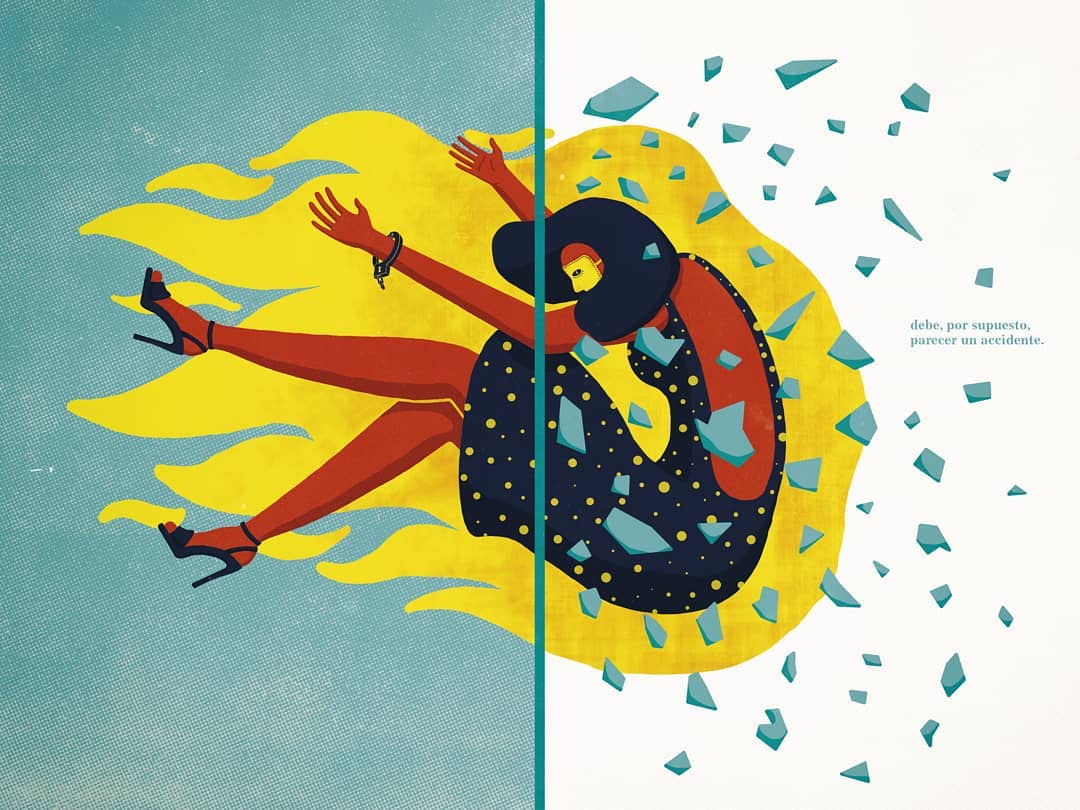▲ A soldier stands guard outside the Cerocahui church.Photo App
H
more than six centuries ago, In 1589, thirsty for gold and precious minerals, the Spanish arrived in Rarámuri territory. They were looking for mines in what is now the municipality of Chínipas, just over 100 kilometers from the parish of Cerocahui, where Jesuit priests Javier Campos and Joaquín César Mora, and tourist guide Pedro Palma, were murdered.
The Tarahumara received them with gifts, but they were forbidden to enter the community. The vedo did not matter to the wealth seekers. They entered the mine displaying their harquebuses. On the hill – wrote the Jesuit priest Ricardo Robles – 2,000 warriors challenged them.
Thus began a history of colonialism, dispossession, exploitation and oppression, but also of resistance, which continues to this day. The old conquistadors are now members of organized crime and their old firearms are now modern AK-47s or AR-15s.
Those first Spaniards confused cordiality with submission. Almost four decades later, the governor of Nueva Vizcaya sent a letter to the viceroy, in which he assured him that those lands were fertile and the Rarámuris reducible and a great kingdom could be established there.
The conquerors did not have it easy. The indigenous people did not want outsiders to impose another way of life on them. So between 1616 and 1698 they staged five major rebellions. The Jesuits established a mission in the San Pablo Valley, now Balleza, in 1608. However, they had to suspend their evangelizing work due to the uprising of the Tarahumara and Tepehuanes in 1620. They continued it in 1639, through the San Felipe mission. of Jesus. The Spanish wanted to drown the rebelliousness in blood and fire. The Rarámuris withdrew into the abysses of the ravines and the mountains, keeping their forms of production and their beliefs alive.
The invaders, explains Robles, they gave up gathering them in towns, banishing their ritual festivals and imposing jobs the way they wanted. They sought political control by appointing indigenous captains and governors, to organize the dispersed into parties.
.
The conquerors appropriated mines, land and militarily controlled the territory. However, they were unable to reduce the indigenous people into populations. The missionaries built temples, organized festivals and brought together the towns with a new system of authorities. The Tarahumaras preserved their freedom, their forms of work and their most significant rites.
In 1767, the Jesuits were expelled from the Spanish dominions. Clerics and Franciscans who clashed with the Indians were sent instead. The ecclesial vacuum facilitated the Rarámurization of the Rarámuris. However, at the same time, the indigenous lands, until then defended by the Laws of the Indies, were invaded. The Tarahumara went further into the mountains and the cliffs.
In 1900, 133 years after their expulsion, the Jesuits returned to the region. They set out to educate the indigenous people. The clash was unavoidable. The Indians resisted the vertical and authoritarian decision to form colonies; to learn trades, abandoning their productive forms; the disavowal of their rites and the imposition of an orthodox religiosity. They did it negotiating their way. Missionary work was regularized until the 1940s.
Things began to change when, according to fellow Jesuit priest Alfredo Zepeda, a critical movement for change was sweeping the world, enveloping everything with unprecedented airs. The Vatican Council began with the slogan of Pope John: open the windows of the convents so that the wind of the spirit could enter, blowing unpredictably
.
It turned out then, Zepeda continues, that a group of religious in those parts, Together with the Jesuit Bishop José Llaguno (1925-1992) and other colleagues, they questioned Western visions in order to approach the Rarámuri worldview. And the people of this town converted them, from bearers of a doctrine, into disciples. From benefactors, they became friends of the men and women of the Sierra Tarahumara, united as companions to their secular resistance in defense of freedom and autonomy.
.
Bishop Llaguno first came to the Tarahumara Mission in 1951. He took charge of the Sisoguichi boarding school. He learned Rarámuri in Norogachi. He lived in the region from 1962 until his death in 1992. He was appointed Bishop of Tarahumara in 1973. That same year he vigorously protested the abuse, mistreatment and murders committed by members of the Operation Condor, under the pretext of the fight against drug trafficking in the region. In 1979 he participated in the third Conference of the Latin American Episcopate in Puebla, and contributed to the elaboration of the document option for the poor
.
The priests Javier Campos and Joaquín Mora, murdered on June 20, were worthy heirs to the legacy of Bishop Llaguno. Father Campos, whom his friends called the Rooster, came to the Tarahumara 50 years ago; Father Mora moved two decades ago. Campos was a moral authority in the diocese. He knew the Rarámuri territory and culture in depth; the value of the festivals, the rites and the secret stories that are told at sunset in the mountains. He promoted the indigenous Church and the inculturation of the gospel. Although Mora’s health was damaged, he refused to leave his work. Both accompanied the Rarámuri people as subjects of their own history and not as objects of colonization.
Beyond their resistance, the Tarahumara live in serious problems. Lawyer Magdalena Gómez summarized them: “Corruption of the authorities, manipulated indigenous governors, erosion of traditional mechanisms, the narco (planting, trafficking and consumption), the ejido and government programs used to divide, as well as religions and political parties; militarization and presence of armed groups, clandestine presence and consumption of drugs and alcohol, lack of employment and therefore migration, family disintegration and identity conflicts for this reason, poor educational attention, self-ignorance, exploitation of natural resources, problems of lands due to the entry of tourist projects, young people in the process of acculturation and their absence or lack of respect at parties, changes in diet”.
The expansion of the criminal industry and the narcopolitics have exacerbated these tragedies. The narco It is also dedicated to cutting down forests. It seeks to incorporate indigenous youth as hawks, mules or assassins. If they do not agree to enter the business, they are expelled from the region or killed. They set fire to the forests of the communities that resist.
According to the DEA, the El Paso-Juárez corridor is an extraordinarily profitable route: about 70 percent of the cocaine that enters the United States from Mexico passes through it. The journalist from the day Miroslava Breach was savagely murdered after documenting the expansion of organized crime and its links to institutional politics, in her native Chínipas, the same municipality where the first Spaniards arrived. Chínipas is a small centennial town founded in 1626 by Jesuit priests to evangelize the indigenous people.
In March 2016, he published a report in this newspaper in which he explained the role of The Salazars in Chinipas. The Salazars are a gang from that municipality, producer and distributor of marijuana, led, until his arrest in 2011, by Adán Salazar Zamorano and his sons, Jesús Alfredo and Adán, part of New people, the subsidiary of the Sinaloa cartel in Chihuahua. They control part of the drug trafficking route and the passage of migrants to the United States. Interestingly, José Noriel Portillo, alias the crookalleged murderer of the Jesuits, is responsible for Plaza de New people in Cerocahui.
As Ricardo Robles explained in these same pages, little more than a year before he died, what is lived in the Tarahumara “is the narcoseedingwhich in some regions has already four generations of drug growers and has made this activity an ordinary way of life, almost the only one now. But it is also the drug haulingthe drug fight for the control of territories, the narco-corruption widespread, the narco-elections bought, the drug dealers of abundant money and are also the drug dealing and the drug consumption… Perhaps the only true novelty is that blood is spattering all of us closely, or that we are all being conquered, tyrannized, subjugated, and that the conquerors are fewer and fewer and they come for everything.”
The murder of the Jesuit priests Javier Campos and Joaquín César Mora, defenders and companions of the Rarámuri people, and the tourist guide Pedro Palma, is a turning point in the region and in the country. They left without asking permission and with their backpack full of stories; it is very easy to be human, but it is very difficult to become human and in them we always find two brothers, two human men
said the Jesuit Javier Ávila, at the mass in honor of his companions. Rest in peace.








